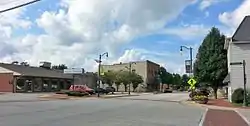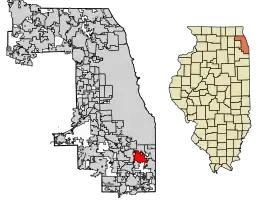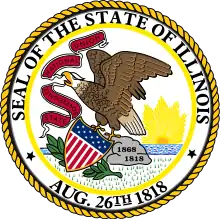South Holland, Illinois
South Holland is a village and south suburb of Chicago in Cook County, Illinois, United States, within Thornton Township. The population was 22,030 at the 2010 census.[6]
South Holland, Illinois | |
|---|---|
Village | |
| Village of South Holland | |
 South Holland Town Center | |
| Motto(s): "A Heritage of Faith; An Emphasis on Family; A Home for Our Future" | |
 Location of South Holland in Cook County, Illinois. | |
.svg.png.webp) Location of Illinois in the United States | |
| Coordinates: 41°36′N 87°36′W | |
| Country | |
| State | |
| County | Cook |
| Township | Thornton |
| Settled | 1847 |
| Incorporated | May 12, 1894 |
| Government | |
| • Type | Council-Trustee |
| • Body | Board of Trustees |
| • Mayor | Don A. DeGraff |
| • Administrator | Jason Huisman |
| • Clerk | Sallie D. Penman |
| • Treasurer | Beth Herman |
| Area | |
| • Total | 7.25 sq mi (18.78 km2) |
| • Land | 7.24 sq mi (18.74 km2) |
| • Water | 0.02 sq mi (0.04 km2) 0.27% |
| Elevation | 601 ft (183 m) |
| Population | |
| • Total | 22,030 |
| • Estimate (2019)[3] | 21,296 |
| • Density | 2,943.06/sq mi (1,136.34/km2) |
| Down .05% from 2000 | |
| Standard of living (2009-11) | |
| • Per capita income | $25,887 |
| • Median home value | $168,600 |
| Time zone | UTC-6 (CST) |
| • Summer (DST) | UTC-5 (CDT) |
| ZIP code | 60473 |
| Area code | 708 |
| FIPS code | 17-70850[4] |
| GNIS feature ID | 0418788[5] |
| Website | www |
| Demographics (2010)[6] | |||
|---|---|---|---|
| White | Black | Asian | |
| 20.5% | 74.2% | 0.6% | |
| Islander | Native | Other | Hispanic (any race) |
| 0.01% | 0.2% | 4.5% | 5.8% |
History
The area currently occupied by South Holland, Illinois, was first settled in 1846 by immigrants from South Holland, Netherlands. When the community formally incorporated as a village in 1894, its population was about 1,000. Originally a general farming community, it later specialized in vegetable growing, especially onion sets. By the 1940s South Holland was known as the "Onion Set Capital of the World". The town was built on low ground near the Calumet River and was originally called de Laage Prairie (Low Prairie) to differentiate it from another Dutch settlement further north on higher ground and called de Hooge Prairie (now the Roseland neighborhood of Chicago).
South Holland was affected by white flight during the 1970s, as white families began to withdraw their students from schools which were desegregated by court order. This withdrawal also manifested in terms of funding, as families who had taken their children out of desegregated public schools saw no reason to contribute money in order to fund them—especially since most of the remaining students were black. Multiple referendums attempting to raise taxes to fund schools in South Holland were defeated by white voters, who had begun sending their children to segregated private schools instead. This reflects a broader pattern in Illinois—and the United States in general—of white resistance to both school desegregation and attempts to obtain more funds through taxes.[7]
In October 2007, Forbes.com declared South Holland to be the "Most Livable Metro-Area suburb" of the Chicago metropolitan area.[8]
Distinctive traits
South Holland is an anomaly in Chicago Southland because of its laws.[9] Most businesses are closed on Sunday, though retail establishments are permitted to remain open. This can be seen easily when driving on one of the village's main thoroughfares—162nd Street or South Park Avenue. South Holland is a "dry" municipality; that is, no alcohol is sold anywhere within the village limits. Additionally, the sale or rental of pornographic material is prohibited in South Holland. The village's franchise agreements with cable television providers restrict adult-oriented programming.[10] Zoning restrictions do not allow the development of apartment buildings or condominiums. These laws are a remnant of the village's religious roots as a settlement of conservative Dutch Reformed immigrants. Even today, South Holland's motto is "A Community of Churches".
Geography
South Holland is located at 41°36′N 87°36′W (41.60, -87.60).[11] It is bordered by Harvey and Phoenix to the west, Dolton to the north, Thornton to the south, and Calumet City and Lansing to the east.
According to the 2010 census, South Holland has a total area of 7.286 square miles (18.87 km2), of which 7.27 square miles (18.83 km2) (or 99.78%) is land and 0.016 square miles (0.04 km2) (or 0.22%) is water.[12]
South Holland's addresses and numbered streets are 3 blocks ahead of Chicago's grid. For example, 159th Street is actually called 162nd Street.
Demographics
| Historical population | |||
|---|---|---|---|
| Census | Pop. | %± | |
| 1890 | 1,005 | — | |
| 1900 | 766 | −23.8% | |
| 1910 | 1,065 | 39.0% | |
| 1920 | 1,247 | 17.1% | |
| 1930 | 1,873 | 50.2% | |
| 1940 | 2,272 | 21.3% | |
| 1950 | 3,247 | 42.9% | |
| 1960 | 10,412 | 220.7% | |
| 1970 | 23,931 | 129.8% | |
| 1980 | 24,977 | 4.4% | |
| 1990 | 22,105 | −11.5% | |
| 2000 | 22,147 | 0.2% | |
| 2010 | 22,030 | −0.5% | |
| 2019 (est.) | 21,296 | [3] | −3.3% |
| U.S. Decennial Census[13] | |||
As of the 2010 census South Holland had a population of 22,030 people. The ethnic and racial makeup of the population was 18.3% non-Hispanic white, 73.8% non-Hispanic African-American, 0.2% Native American, 0.6% Asian, 0.1% non-Hispanics reporting some other race, 1.5% reporting two or more races and 5.8% Hispanic or Latino.[14]
As of the census[4] of 2000, there were 22,147 people, 7,663 households, and 6,007 families residing in the village. The population density was 3,042.1 people per square mile (1,174.6/km2). There were 7,825 housing units at an average density of 1,074.8 per square mile (415.0/km2). The racial makeup of the village was 50.81% African American, 45.04% White, 0.17% Native American, 0.86% Asian, 0.01% Pacific Islander, 1.93% from other races, and 1.18% from two or more races. Hispanic or Latino of any race were 3.77% of the population.
There were 7,663 households, out of which 33.3% had children under the age of 18 living with them, 61.8% were married couples living together, 12.9% had a female householder with no husband present, and 21.6% were non-families. 19.4% of all households were made up of individuals, and 11.0% had someone living alone who was 65 years of age or older. The average household size was 2.82 and the average family size was 3.24.
In the village, the population was spread out, with 25.6% under the age of 18, 7.0% from 18 to 24, 25.5% from 25 to 44, 24.3% from 45 to 64, and 17.7% who were 65 years of age or older. The median age was 40 years. For every 100 females, there were 89.2 males. For every 100 females age 18 and over, there were 83.6 males.
The median income for a household in the village was $60,246, and the median income for a family was $67,451. Males had a median income of $46,582 versus $35,557 for females. The per capita income for the village was $24,977. About 2.8% of families and 4.6% of the population were below the poverty line, including 4.9% of those under age 18 and 4.2% of those age 65 or over.
Government
South Holland is in Illinois' 2nd congressional district.
Notable people
- Eddy Curry, forward for the Chicago Bulls, New York Knicks, and Miami Heat
- Kevin DeYoung, pastor, author
- Kevin Drumm, musician
- Cliff Floyd, All-Star outfielder for seven Major League Baseball teams
- Norman J. Kansfield, minister noted for being suspended after officiating at his daughter's same-sex marriage
- James Meeks, state senator, representing Illinois' 15th district
- Mark Mulder, pitcher for the Oakland Athletics and St. Louis Cardinals
- Frederick Nymeyer, industrialist, author, and publisher
- Robert Shaw, former Chicago alderman and former commissioner of the Cook County Board of Review[15]
- Steve Trout, pitcher for the Chicago White Sox, Chicago Cubs, New York Yankees, and Seattle Mariners
- Jason Weaver, actor and singer
Education
South Holland is served by several school districts:
- South Holland School District 150[16]
- Greenwood School (K-3)
- McKinley School (4-8)
- South Holland School District 151[17]
- Taft School (PreK-1)
- Eisenhower School (2-3)
- Madison School (4-5)
- Coolidge Junior High School (6-8)
Thornton Township High School District 205[18] serves all of South Holland.
Thornwood High School is located in South Holland. Thornridge High School and Thornton Township High School are also within District 205.
The private K-8 schools, Christ Our Savior Catholic School, Calvin Christian School and Calvary Academy, are located in South Holland. Seton Academy was a Catholic co-educational high school located in the village. It was formerly an all-girls school until 2003 when boys were admitted. Seton Academy closed on June 30, 2016.[19]
South Holland is home to the main campus of South Suburban College.[20]
In literature
The 1925 Pulitzer Prize-winning novel So Big by Edna Ferber is set in South Holland. The Widow Paarlberg inspired one of the main characters and her family farm is preserved in a municipal park.
References
- "2019 U.S. Gazetteer Files". United States Census Bureau. Retrieved July 14, 2020.
- "Archived copy". Archived from the original on 2012-05-31. Retrieved 2011-12-06.CS1 maint: archived copy as title (link)
- "Population and Housing Unit Estimates". United States Census Bureau. May 24, 2020. Retrieved May 27, 2020.
- "U.S. Census website". United States Census Bureau. Retrieved 2008-01-31.
- "US Board on Geographic Names". United States Geological Survey. 2007-10-25. Retrieved 2008-01-31.
- "Profile of General Population and Housing Characteristics: 2010 Demographic Profile Data (DP-1): South Holland village, Illinois". U.S. Census Bureau, American Factfinder. Archived from the original on February 12, 2020. Retrieved March 20, 2013.
- Steffes, Tracy L. (February 2020). "Assessment Matters: The Rise and Fall of the Illinois Resource Equalizer Formula". History of Education Quarterly. 60 (1): 24–57. doi:10.1017/heq.2020.7.
- "Most Livable Metro-Area Suburbs". Forbes. 11 October 2007.
- "Distinctive Traits". Village of South Holland.
- "Statement regarding the availability of "on-demand" cable programming". Village of South Holland.
- "US Gazetteer files: 2010, 2000, and 1990". United States Census Bureau. 2011-02-12. Retrieved 2011-04-23.
- "G001 - Geographic Identifiers - 2010 Census Summary File 1". United States Census Bureau. Archived from the original on 2020-02-13. Retrieved 2015-12-25.
- "Census of Population and Housing". Census.gov. Retrieved June 4, 2015.
- "U.S. Census website". Retrieved 2016-01-09.
- Seidel, Jon (13 March 2014). "Former Ald. Robert Shaw to run for mayor". Chicago Sun-Times. Retrieved 18 November 2020.
- South Holland School District 150
- "South Holland School District 151". Archived from the original on 2000-04-08. Retrieved 2007-05-11.
- Thornton Township High School District 205
- "Archived copy". Archived from the original on 2016-10-22. Retrieved 2016-10-21.CS1 maint: archived copy as title (link)
- South Suburban College

